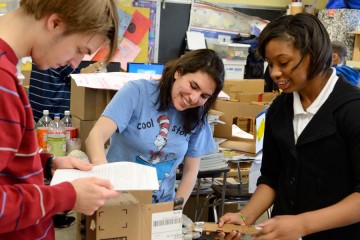The Johns Hopkins University and Baltimore City Public Schools have partnered to create the city's first pre-K through eighth grade school dedicated to giving students a foundation in engineering and computer skills.
Image caption: Barclay Elementary/Middle School principal Armanda Carr greets Johns Hopkins University President Ronald J. Daniels at Wednesday's event.
Image credit: Will Kirk / Johns Hopkins University
Every class at the Barclay Elementary/Middle School—not just science and math but also reading, social studies, and even art—will feature elements of engineering and computer science, using a curriculum supported by educators at the Johns Hopkins Whiting School of Engineering. And every student has access to a new laboratory, co-founded by city schools and the university, that is outfitted with cutting-edge technology including 3D printers, custom-programmed computers, smartboards, and a makerspace where students can design and build.
All together, the partnership represents a 10-year, multimillion-dollar commitment—with Johns Hopkins investing nearly $5 million—intended to spark higher achievement at Barclay, prepare the students for 21st-century careers, and strengthen the neighborhood surrounding the university's Homewood campus.
"Our goal is to provide these students with a foundation in critical thinking, problem-solving skills, and collaboration that will enable them to pursue further studies and, ultimately, careers in STEM fields," said Ed Schlesinger, dean of the Whiting School. "At the same time, the curriculum will reinforce their studies in a myriad of subjects—from honing their math, written, and verbal communications skills to serving as a vehicle through which to better understand social studies and economics."
Also see: Hopkins opens new engineering lab in city elementary school (The Baltimore Sun)
University and school officials spoke about the new initiative this morning during an media event at the school, which is located at 2900 Barclay St., a few blocks from the university's Homewood campus.
The effort is part of the university's Homewood Community Partners Initiative, a plan to strengthen and grow the 10 neighborhoods surrounding the Homewood campus. In 2012, Johns Hopkins University President Ronald J. Daniels pledged $10 million over five years to support the program.
"Successful public schools are the foundation and the glue of strong neighborhoods," Daniels said. "This partnership stands as a long-term commitment both to Barclay students and to our Baltimore community."
The new engineering-infused curriculum emphasizes hands-on problem-solving and critical thinking—not just in science and math classes but in courses where one might not expect to find them. For example, second-graders will learn about children in Africa who cook with solar ovens to preserve wood and then will build a solar oven.
In the lab's makerspace, students will be able to see their creations come to life. For instance, fifth-graders will create a windmill that generates enough electricity to power a lightbulb. Older students will use inventor software to design a playground.
There will also be opportunities for students to identify and solve problems in their own neighborhoods through engineering-based approaches.
Barclay's 120 new computers, custom-programmed to teach engineering, will allow students to program toy robots and use their imagination to design objects that become tangible through the 3-D printers.
The university will assist with weekend and summer enrichment programs to keep students and teachers engaged. Older students, meanwhile, will have opportunities to visit Johns Hopkins to tour real engineering and robotics labs and meet students studying to become engineers.
The university and city school system hope Barclay will be a model for other cities hoping to tap collegiate expertise to support and inspire public school students.
"This partnership will truly help us provide meaningful and engaging experiences for our students," said Armanda Carr, principal of Barclay Elementary/Middle School. "They will get exposure to a variety of engineering career choices during their everyday classroom instruction. I can't wait to see the great things that our students will discover and produce."
Posted in University News, Community
Tagged community, stem education, baltimore








